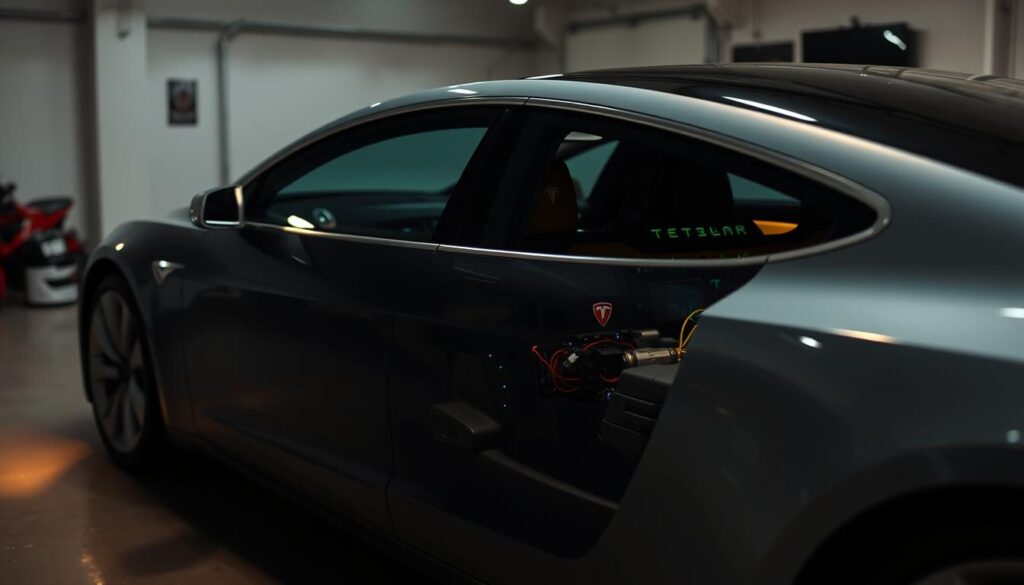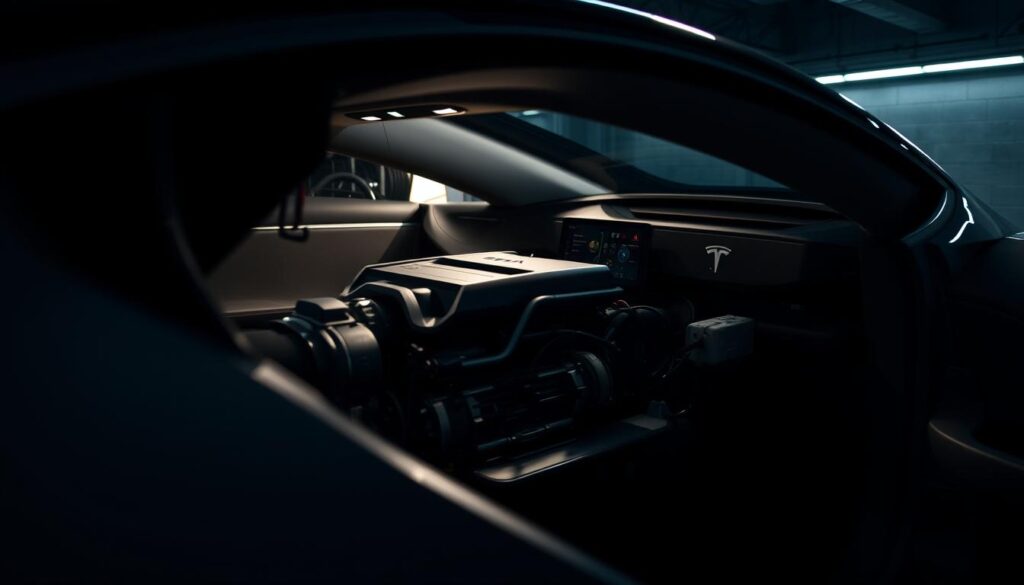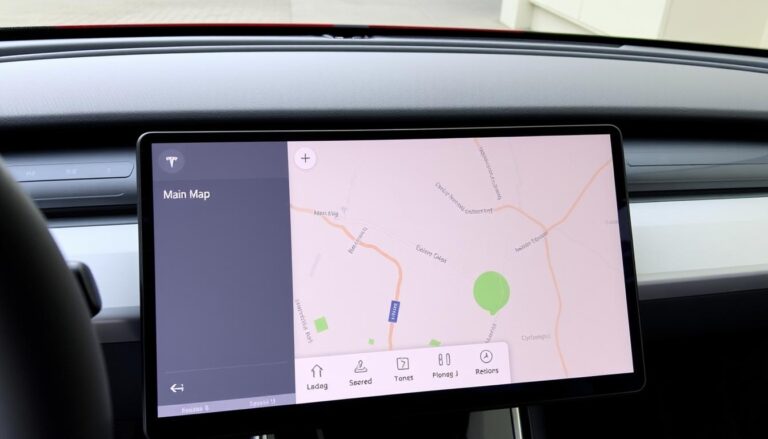As a Tesla owner, you may have noticed that your vehicle makes various sounds even when it’s parked. This can be concerning, but in most cases, these noises are normal and related to the vehicle’s systems.
The sounds can range from gentle humming to more pronounced noises, leaving you wondering what’s causing them. In this article, we will explore the different reasons behind Tesla parked sounds and provide guidance on how to address any issues.
Key Takeaways
- Understanding the normal operational sounds of your Tesla
- Identifying potential causes of unusual noises when parked
- Learning how to address concerns related to Tesla noise
- Recognizing when to seek professional assistance
- Maintaining your Tesla to minimize unusual sounds
Understanding Tesla’s Normal Operational Sounds
Understanding the normal operational sounds of your Tesla is crucial for a seamless ownership experience. Tesla’s advanced technology incorporates several systems that can produce distinct sounds.
Battery Thermal Management System
The battery thermal management system is crucial for maintaining the optimal temperature of Tesla’s battery pack. This system can produce a humming or whirring noise, especially when the vehicle is regulating the battery temperature.
Heat Pump and HVAC System Noises
The heat pump and HVAC system in Tesla vehicles can also generate various noises. These sounds can range from rattling to clicking and are generally considered normal operational noises.
Sentry Mode and Software Update Sounds
Sentry Mode is a feature that uses the vehicle’s cameras to deter potential threats. It can cause the vehicle to make sounds, such as alarm noises. Additionally, software updates can sometimes result in unusual sounds during the update process.
| System | Normal Sounds |
|---|---|
| Battery Thermal Management | Humming, Whirring |
| Heat Pump and HVAC | Rattling, Clicking |
| Sentry Mode | Alarm Noises |

Why Does My Tesla Make Noise When Parked?
Parked Teslas can produce a variety of noises, some of which are normal operational sounds, while others might indicate potential issues. Understanding the source of these noises is crucial for determining whether your vehicle is functioning as expected or if there’s a need for further inspection. The range of sounds can vary significantly across different Tesla models.
Normal Sounds: Pumps, Fans, and Clicks
Teslas, like many electric vehicles, are equipped with various systems that can generate noise even when the car is parked. Normal operational sounds include the hum of pumps, the whir of fans, and occasional clicks. These noises are typically associated with the vehicle’s thermal management system, battery conditioning, or other background processes.
For instance, the battery thermal management system may activate to maintain optimal battery temperature, resulting in a gentle humming or whirring noise. Similarly, fans may operate to cool down the vehicle’s systems or cabin. These sounds are generally considered normal and are part of Tesla’s operational profile.

Abnormal Noises: Grinding, Whining, and Rattling
While many noises are normal, others can be indicative of potential issues. Abnormal noises such as grinding, whining, or rattling sounds when your Tesla is parked are worth investigating. Grinding noises might suggest a problem with the vehicle’s mechanical components or the braking system.
Whining sounds could be related to the electrical systems or the charging process. Rattling noises might indicate loose items within the vehicle or issues with the exterior or interior fittings. Identifying the source of these abnormal noises is crucial for diagnosing any potential problems.
Model-Specific Noises (Model 3, Y, S, and X)
Different Tesla models can exhibit unique noises due to their design and features. For example, the Tesla Model 3 and Model Y might produce distinct sounds related to their more streamlined design and specific hardware configurations. In contrast, the Tesla Model S and Model X, with their more complex features like falcon-wing doors, may have additional noises associated with these unique features.
Understanding these Tesla model-specific noises can help owners differentiate between normal operational sounds and potential issues. It’s also worth noting that software updates can sometimes introduce new sounds or alter existing ones as Tesla continues to refine its vehicles’ performance and features.
Diagnosing Specific Tesla Noises When Parked
Understanding the various sounds your Tesla makes while parked is crucial for diagnosing potential issues. The Tesla app plays a significant role in this diagnostic process.
Using the Tesla App to Check Vehicle Status
The Tesla app allows owners to monitor their vehicle’s status remotely. You can check the battery level, ensure there are no error messages, and even monitor the vehicle’s surroundings if Sentry Mode is enabled. To effectively use the app for diagnosing noises, follow these steps:
- Open the Tesla app on your smartphone.
- Navigate to the ‘Status’ section to check for any alerts or error messages.
- Review the ‘Energy’ tab to monitor power consumption.
By regularly checking the Tesla app, you can identify any unusual activity or notifications that may correlate with the noises you’re hearing.
Cooling System and Battery Management Sounds
Tesla’s cooling system and battery management are crucial for maintaining optimal vehicle performance. Sometimes, these systems can produce noticeable sounds, especially when the vehicle is parked and in a state of readiness or charging.
The cooling system may activate to cool the battery or other components, resulting in fan noises. Similarly, the battery management system (BMS) works to maintain battery health, occasionally producing clicks or other operational sounds.
Phantom Drain and Related Noises
‘Phantom drain’ refers to the unexpected depletion of the battery when the vehicle is parked. This can sometimes be accompanied by various noises due to the vehicle’s systems operating in the background.
How to Monitor Power Consumption
To monitor power consumption and potentially identify the cause of phantom drain, use the Tesla app to check energy usage. Look for patterns or spikes in consumption that could indicate which system is causing the drain.
- Check the ‘Energy’ tab in the Tesla app.
- Review the ‘Power Consumption’ details.
- Look for any unusual patterns or high consumption when the vehicle is parked.
By closely monitoring your Tesla’s power consumption and understanding the normal operational sounds, you can better diagnose and potentially resolve issues related to noises when your vehicle is parked.
Troubleshooting and Resolving Tesla Noises
When your Tesla makes noise while parked, it can be concerning, but there are several methods to diagnose and resolve the issue. Troubleshooting these noises often involves a combination of software checks, adjusting vehicle settings, and potentially scheduling a service appointment.
Software Solutions: Rebooting and Updates
One of the first steps in troubleshooting Tesla noises is to ensure your vehicle’s software is up to date. Tesla frequently releases software updates that can resolve known issues, including those related to noise. To check for updates:
- Go to the Tesla app on your phone.
- Navigate to ‘Software Update’.
- If an update is available, follow the prompts to download and install it.
Additionally, rebooting your Tesla can sometimes resolve software glitches that may be causing the noise. To reboot your Tesla:
- Press and hold both scroll buttons on the steering wheel for 10 seconds.
- Release and wait for the Tesla logo to appear on the screen.
Adjusting Settings to Reduce Parked Noises
Sometimes, the noise can be related to specific features or settings on your Tesla. For example, adjusting the settings related to Sentry Mode or the HVAC system can help reduce or eliminate the noise.
| Setting | Description | Potential Impact on Noise |
|---|---|---|
| Sentry Mode | A feature that uses cameras to monitor the surroundings. | Disabling or adjusting sensitivity may reduce noise. |
| HVAC System | Heating, ventilation, and air conditioning system. | Adjusting temperature settings or turning it off when not needed can help. |
When to Schedule Tesla Service
If the noise persists after trying the above steps, it may be necessary to schedule a service appointment with Tesla. Some noises can indicate a hardware issue that requires professional attention.
Using the Tesla Mobile Service Option
Tesla offers a mobile service option where technicians can come to your location to perform certain services. This can be convenient for diagnosing and potentially resolving the issue without having to visit a service center.
To use the Tesla mobile service:
- Open the Tesla app.
- Go to ‘Service’.
- Select ‘Mobile Service’ and follow the prompts.
By following these steps, you can troubleshoot and potentially resolve the noises your Tesla is making while parked. If the issue persists, Tesla’s service team is available to provide further assistance.
Conclusion
Understanding the reasons behind Tesla noises when parked is crucial to resolving the issue. By following the troubleshooting steps outlined in this article, you can identify and address the root cause of the noise, ensuring a quieter driving experience.
Tesla’s advanced technology, including its battery thermal management system and Sentry Mode, can sometimes cause unexpected noises. However, by adjusting settings and performing software updates, you can minimize these sounds. For more information on common car sounds and their causes, visit Automotive Simple.
Resolving Tesla parked noise issues requires patience and a thorough understanding of your vehicle’s systems. By taking the steps outlined in this article, you can enjoy a more peaceful driving experience and reduce unnecessary noise. Effective Tesla noise resolution is within your reach.
FAQ
Why is my Tesla making a humming noise when parked?
The humming noise is likely due to the battery thermal management system, which is responsible for maintaining the optimal temperature of the battery.
What are normal operational sounds for a Tesla when parked?
Normal operational sounds for a Tesla when parked include pumps, fans, and clicks, which are related to the vehicle’s systems, such as the battery thermal management system and heat pump.
How can I diagnose the source of the noise using the Tesla app?
You can use the Tesla app to check the vehicle’s status, including its battery level and any error messages, to help diagnose the source of the noise.
Can software updates resolve Tesla noises when parked?
Yes, software updates can potentially resolve Tesla noises when parked, and it’s recommended to keep your vehicle’s software up to date.
When should I schedule Tesla service for unusual noises?
If you’re experiencing unusual or persistent noises, it’s recommended to schedule Tesla service to have the issue diagnosed and resolved by a certified technician.
How can I reduce parked noises by adjusting settings?
You can adjust settings, such as disabling Sentry Mode or adjusting the climate control system, to reduce parked noises.
What is phantom drain, and how is it related to Tesla noises?
Phantom drain refers to the vehicle’s battery draining when it’s parked, which can be related to various noises, such as the cooling system or battery management system.
Can I use the Tesla mobile service option to resolve noise issues?
Yes, the Tesla mobile service option allows certified technicians to diagnose and repair issues, including noise-related problems, at your location.


